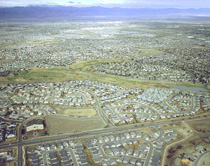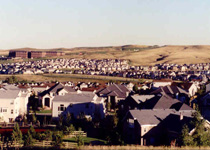 |

|
| Wessman Home | People | Projects | Contact |
| RESEARCH GROUPS @ CIRES > |
Social-ecological Systems in Urban EnvironmentsUrban ecosystems depart from the regional native ecosystems in which they reside. In a sense, they are new ecological systems, with complex and broad-ranging resource demands and socioeconomic forces absent in the original 'wild' environment. The feedbacks between natural and social functions have not been sufficiently examined, theoretically or empirically, in the context Research by Dr. Nancy Golubiewski on Colorado Front Range primary productivity and carbon storage showed that the suburban lawn ecosystem fosters twice the productivity of native grasslands and stores more soil carbon in surface layers than agricultural systems (Golubiewski 2003). Suburban-lot carbon pools increased through time and surpassed those of grasslands in the second decade after site construction due to increases in both soil organic carbon and woody vegetation carbon pools. The comparison of carbon storage in the vegetated spaces of urban areas to that in grasslands and agricultural fields reveals a marked increase as well as a proportional shift in storage from belowground to aboveground. Preliminary extrapolation of these values to determine a regional carbon content trajectory between 1930 and 1990 suggests an 18% gain based on generalized maps of land-use/land-cover categories or a 3% loss in carbon using a biophysical approach based on vegetative and impervious covers as derived from remote sensing analysis. The actual trajectory in regional carbon content change with urbanization lies somewhere in between these values, as overestimates occur with categorical extrapolations and characterization of historical landscaping choices and trends are poorly known.
|
 of an urbanizing environment. In the arid to semi-arid western United States, the transformation of grasslands to matrices of built and landscaped urban 'forests' forces changes in carbon pools and fluxes that may be unsustainable, and thereby endanger local and regional ecological goods and services such as water supplies and nutrient cycling.
of an urbanizing environment. In the arid to semi-arid western United States, the transformation of grasslands to matrices of built and landscaped urban 'forests' forces changes in carbon pools and fluxes that may be unsustainable, and thereby endanger local and regional ecological goods and services such as water supplies and nutrient cycling.  We intend on expanding our work in the area of urban ecology. The concept of urban systems as emergent properties of natural and socioeconomic interactions (Alberti et al. 2004) suggests that there are urban system properties that currently elude us and which are critical to understanding the features of resilience that will sustain urban systems in changing environmental conditions. We seek to understand the functioning of the anthropogenic landscape, reveal vulnerabilities to resource crises (e.g. regional drought, rapid growth) and ultimately aid in developing mitigation measures in land-use planning and policy-making to increase adaptability to crises.
We intend on expanding our work in the area of urban ecology. The concept of urban systems as emergent properties of natural and socioeconomic interactions (Alberti et al. 2004) suggests that there are urban system properties that currently elude us and which are critical to understanding the features of resilience that will sustain urban systems in changing environmental conditions. We seek to understand the functioning of the anthropogenic landscape, reveal vulnerabilities to resource crises (e.g. regional drought, rapid growth) and ultimately aid in developing mitigation measures in land-use planning and policy-making to increase adaptability to crises.